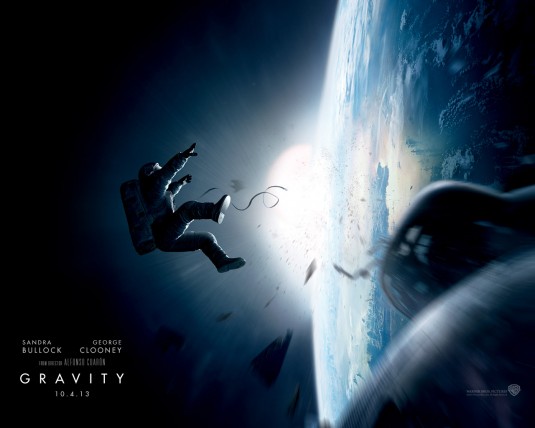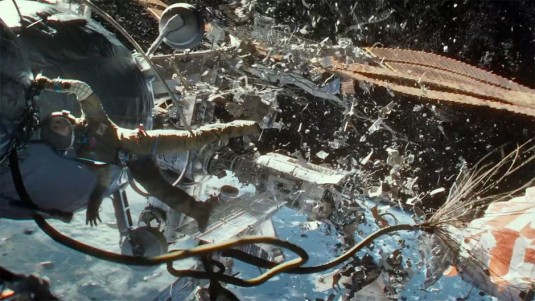Gravity, by Alfonso Cuarón and his son Jonas represents the start of a new generation of 3D film that no longer needs to showcase depth effects, but draws the audience into the screen.
By Kathleen Maher
The death knell has been sounding for 3D movies ever since the summer season looked like a loser with several big effects movies that tanked in the U.S. including The Wolverine and Turbo. A lot of big know-it-alls also put Pacific Rim in the loser category, but it opened reasonably well in the U.S. and went on to score over $400 million in world markets. According to Box Office Mojo, the film earned 71% of its revenues overseas. The fact of the matter is the rest of the world still really loves 3D and American audiences are going to fall in love again once Gravity hits the big screen.

The filmmakers take advantage of 3D in a way no other filmmaker has done and that includes 3D’s patron saint James Cameron. At a screening of the film at Dolby’s fabulous screening room in San Francisco, Cuarón introduced the film in a promotional video for Dolby. He said he had to wait for the technology to exist before he made Gravity and it’s true, Gravity takes advantage of the 3D audio available through Dolby’s Atmos technology, as well as 3D stereography, and digital filmmaking in ways that have never been done before. It is not a stretch at all to compare Gravity to Apocalypse Now. Both films changed the course of filmmaking and film presentation. That earlier film broke ground in many areas including the Academy Award winning work of cinematographer Vittorio Storaro, but its use of sound was breath taking. Apocalypse Now attempted to recreate the chaos of war by taking advantage of the most advanced stereo techniques available at the time to create a sound landscape. Walter Murch’s audio design assaults the audience with sounds coming from all directions, and frightens the audience with quiet, creepy darkness. Anyone who saw Apocalypse Now in the original 70 mm wide screen with the then-new Dolby 70 mm sound system will never forget the effect of the opening scenes. Actually, as I went back to look up information about Apocalypse Now I was surprised to learn that the sound system that had so impressed me was one of an early example of Dolby surround and engineers had created special technology for the movie, but it makes sense and Gravity represents another important step in the evolution of cinematic sound.
Dolby Atmos premiered for American audiences with Brave in 2012, the first theater equipped with the technology was the Dolby Theatre in Hollywood, California. More than 300 Dolby Atmos screens have been installed or committed to in 30 countries and more than 75 films have been made or are in the process of being made with Atmos sound. The format enables movies to be distributed with an unlimited number of audio tracks to theaters, which can then be dynamically rendered depending on the theater’s facilities.
Atmos creates an audio scape for a film using sound objects in the same way a scene is populated with objects and characters. Theaters equipped with the Dolby Atmos Cinema Processor can recreate the filmmakers’ intent and place sounds in space in the theater. Gravity takes advantage of Atmos to immerse the viewer in the movie. Sounds really do seem to come from where they are in the movie universe heightening the effect of floating in space. But obviously, sound is just one part of the equation.
New territory
At NAB, 2012 Alfonso Cuarón talked to writer and filmmaker Debra Kaufman in an interview hosted by Autodesk about how the tools of filmmaking have evolved to the point where making Gravity was possible. Cuarón said he had long wanted to use digital cameras in a movie, and in fact considered the technology for Children of Men, but he and cinematographer Emmanuel (Chivo) Lubezki (Cuarón’s Y Tu Mamá También, Terrance Malick’s Tree of Life, The Coen Brothers Burn After Reading) didn’t think the quality was good enough. They both thought the cameras of the time could not deliver the blacks and whites or the resolution they wanted. But when they began working on Gravity, Lubezki came to Cuarón and showed him what the cameras can do. The imagery of Gravity and in fact, it could be said the movie is all about black and white, space and nothingness, all bright light and total darkness, sound and silence. And of course it’s about space and gravity and no gravity. For much of the shoot, Sandra Bullock is shot in rigs, suspended by thin wires and she’s alone in shots. The camera moves around her, tracks with her, and sometimes takes almost an active role as the eye of the audience. The filmmakers have said that they were trying to make the audience feel at times that they are floating in space. It works.
Cuarón tells the The Wrap, (Alfonso Cuarón’s 10 Laws of Gravity) “I remember the first day we started to test rigs, I was shooting with Chivo [cinematographer Emmanuel Lubezki], and I said, ‘Well, not so bad, no?’ And he said, ‘What are you talking about? This is absolutely horrible, and you know it!’”
In fact, one of the questions begging to be asked is how in the hell did this film ever get made. Imagine a pitch meeting in which the director says he and his son have written a story about two astronauts floating in space. Mind you, the film did not originally come packaged with big box office stars George Clooney and Sandra Bullock. Alfonso Cuarón and his son Jonas began active work on the film in 2009 when they finished the script, and they have been tireless in their work to get the film made and now to publicize it.
The film took an enormous amount of time to be completed after shooting because the film is pretty much all CG and during shooting every move had to be perfect. The filmmakers created a device they called the Light Box, a cube of 4,096 programmable LEDs that could be programmed to deliver variations of brightness, color, and speed to simulate the light from the earth and the sun as Bullock spins around. There was also a camera on a mechanical arm that could travel around Bullock, suspended in the box. All that’s hard enough, but because the movie is so CG heavy, every move Bullock makes had to be carefully synchronized to be sure it would match the CG.
And in the end, the Cuaróns have created a movie that is a true 3D movie experience for the audience and it’s a marvelous thrill ride. If Avatar was the film that proved 3D could be a storytelling tool that helps make the movie. Gravity is the film that extends the language of 3D. The audience is never really aware of the 3D effect, they’re just in it. After a screening of Gravity, the first sound you heard is people taking a deep breath.
The film industry can take a deep breath on this one too, because this advances 3D filmmaking several giant steps forward. You can be sure directors are going to be watching this movie over and over again to see how Cuarón uses 3D so well.

Next-gen filmmaking
In 2012, Cuarón told Kaufman that he found working with his son very enlightening because he learned from Jonas. “I learned I was stuck in my ways.” He was impressed by the way Jonas embraces technology and finds it to be fun. Cuarón said that there is a new generation of filmmakers on the way who will take better advantage of digital pipelines than do the current generation of established filmmakers. “There’s a new generation that’s going to be fearless,” he said. “I recognize the importance of digital, but there’s a new generation whose language is digital.” At that time, in the winter of 2012, the film was almost a year and a half away from release. Watching Gravity, I wondered if the elder Cuarón still feels that way. With this movie, Cuarón proves himself to be pretty fluent in digital and in visual and audio 3D.
As this is being written, on the eve of Gravity’s opening, the film is already a hit. The reviews have been great and ticket pre-sales are reaching record breaking levels and 91% of the ticket sales are for 3D theaters. It’s this year’s Avatar as far as providing movie goers a great escape to put on the glasses and settle down into an immersive experience but it’s more than that too. It’s the start of a new generation of 3D films. No, they won’t all be this good or this innovative, but filmmakers are sure going to try.





